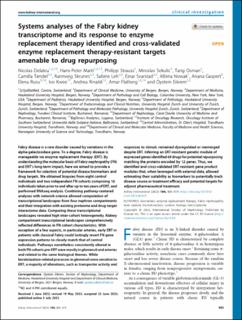| dc.contributor.author | Delaleu, Nicolas | |
| dc.contributor.author | Marti, Hans Peter | |
| dc.contributor.author | Strauss, Philipp | |
| dc.contributor.author | Sekulic, Miroslav | |
| dc.contributor.author | Osman, Tarig Al-Hadi | |
| dc.contributor.author | Tøndel, Camilla | |
| dc.contributor.author | Skrunes, Rannveig | |
| dc.contributor.author | Leh, Sabine | |
| dc.contributor.author | Svarstad, Einar | |
| dc.contributor.author | Nowak, Albina | |
| dc.contributor.author | Gaspert, Ariana | |
| dc.contributor.author | Rusu, Elena | |
| dc.contributor.author | Kwee, Ivo | |
| dc.contributor.author | Rinaldi, Andrea | |
| dc.contributor.author | Flatberg, Arnar | |
| dc.contributor.author | Eikrem, Øystein Solberg | |
| dc.date.accessioned | 2023-12-01T12:43:41Z | |
| dc.date.available | 2023-12-01T12:43:41Z | |
| dc.date.created | 2023-07-06T00:16:26Z | |
| dc.date.issued | 2023 | |
| dc.identifier.issn | 0085-2538 | |
| dc.identifier.uri | https://hdl.handle.net/11250/3105613 | |
| dc.description.abstract | Fabry disease is a rare disorder caused by variations in the alpha-galactosidase gene. To a degree, Fabry disease is manageable via enzyme replacement therapy (ERT). By understanding the molecular basis of Fabry nephropathy (FN) and ERT’s long-term impact, here we aimed to provide a framework for selection of potential disease biomarkers and drug targets. We obtained biopsies from eight control individuals and two independent FN cohorts comprising 16 individuals taken prior to and after up to ten years of ERT, and performed RNAseq analysis. Combining pathway-centered analyses with network-science allowed computation of transcriptional landscapes from four nephron compartments and their integration with existing proteome and drug-target interactome data. Comparing these transcriptional landscapes revealed high inter-cohort heterogeneity. Kidney compartment transcriptional landscapes comprehensively reflected differences in FN cohort characteristics. With exception of a few aspects, in particular arteries, early ERT in patients with classical Fabry could lastingly revert FN gene expression patterns to closely match that of control individuals. Pathways nonetheless consistently altered in both FN cohorts pre-ERT were mostly in glomeruli and arteries and related to the same biological themes. While keratinization-related processes in glomeruli were sensitive to ERT, a majority of alterations, such as transporter activity and responses to stimuli, remained dysregulated or reemerged despite ERT. Inferring an ERT-resistant genetic module of expressed genes identified 69 drugs for potential repurposing matching the proteins encoded by 12 genes. Thus, we identified and cross-validated ERT-resistant gene product modules that, when leveraged with external data, allowed estimating their suitability as biomarkers to potentially track disease course or treatment efficacy and potential targets for adjunct pharmaceutical treatment. | en_US |
| dc.language.iso | eng | en_US |
| dc.publisher | Elsevier | en_US |
| dc.rights | Navngivelse 4.0 Internasjonal | * |
| dc.rights.uri | http://creativecommons.org/licenses/by/4.0/deed.no | * |
| dc.title | Systems analyses of the Fabry kidney transcriptome and its response to enzyme replacement therapy identified and cross-validated enzyme replacement therapy-resistant targets amenable to drug repurposing | en_US |
| dc.type | Journal article | en_US |
| dc.type | Peer reviewed | en_US |
| dc.description.version | publishedVersion | en_US |
| dc.rights.holder | Copyright 2023 International Society of Nephrology | en_US |
| cristin.ispublished | true | |
| cristin.fulltext | original | |
| cristin.qualitycode | 2 | |
| dc.identifier.doi | 10.1016/j.kint.2023.06.029 | |
| dc.identifier.cristin | 2161111 | |
| dc.source.journal | Kidney International | en_US |
| dc.source.pagenumber | 803-819 | en_US |
| dc.identifier.citation | Kidney International. 2023, 104 (4), 803-819. | en_US |
| dc.source.volume | 104 | en_US |
| dc.source.issue | 4 | en_US |

